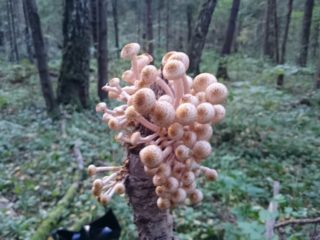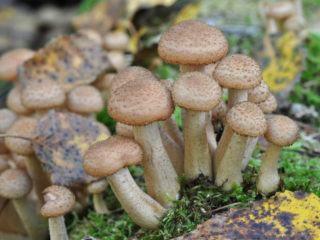Content
Honey mushrooms are one of the most common forest mushrooms, they are the most common and have many varieties, both edible and poisonous.The gray honey fungus is classified as a false representative of the family and is considered conditionally edible. Thanks to its mild taste after proper heat treatment and pleasant aroma, it has earned love and respect from mushroom pickers.
What does the sulphurous honey fungus look like?
Seroplate false honey fungus (other names: poppy honey fungus, pine honey fungus) belongs to the Strophariev family and has an external resemblance to its relatives. The color of the mushroom is yellow or light orange, diluted with reddish, brownish spots. The hymenophore in young individuals is white, later – bluish-gray, with the characteristic color of poppy seeds. False honey fungus has thin, light flesh that does not change color when cut. Its smell is mushroomy, pleasant, with a hint of dampness in older specimens.
Description of the cap
The cap of a young honey fungus is convex, hemispherical, and with age it takes on a more prostrate shape. The diameter of the cap is from 3 to 8 cm, the color is from light yellow to light brown. The shade depends on the place of growth. In humid places the color is rich, in dry places it is pale and dull. Remnants of the coverlet may be visible on the inside of the cap.
Description of the leg
The straight, cylindrical leg acquires a slightly curved shape with age. It grows up to 10 cm and has an uneven color: yellow at the top, darker, rusty brown at the bottom. Its center is hollow, there is no ring, but remains of the veil can be observed.
A useful video will help you learn more about gray-plated honey mushrooms:
Where and how does it grow
The gray honey fungus (hypholoma capnoides) grows in the temperate climate of central Russia, in Europe and in some places in the northern hemisphere.It is a tree fungus and settles on fallen stumps, rotting wood, and the roots of only coniferous trees hidden in the soil. Most often, this representative grows in the lowlands, but is also found in mountainous areas.
When can you collect sulfur-plated honey mushrooms?
Collect sulfur plates false honey mushrooms You can start from late spring until the coldest weather. In regions with a mild climate, they are collected even in winter - in December. Peak fruiting occurs between September and October. Mushrooms, like all honey mushrooms, grow in large groups, clumps, but are very rare alone.
Is the mushroom edible or not?
Seroplate false fungus belongs to the conditionally edible mushrooms of the 4th category. It is eaten only after preliminary heat treatment - boiling for 15 - 20 minutes. To prepare a variety of mushroom dishes, only the caps of young, not overgrown specimens are used. The legs are not suitable for food, as they are tough, fibrous and have a rather unpleasant taste.
How to cook sulfur-plated honey mushrooms
Main courses are prepared from sulfur-plated false mushrooms. After the obligatory boiling, they are fried with the addition of onions, mushroom sauces are prepared, pickled or salted. The broth is drained and not used for food. For harvesting for the winter, the drying method is used.
How to marinate poppy mushrooms with garlic and horseradish
Required ingredients:
- 1 kg of mushrooms;
- 2 tbsp. l. salt;
- 1 tbsp. l. Sahara;
- 500 ml water;
- 2 tbsp. l. table vinegar;
- spices - 2 - 3 cloves of garlic, 2 - 3 cloves, 2 leaves each of horseradish, laurel and currants.
Prepare pickled sulfur-plated honey mushrooms only after preliminary boiling for 20 minutes.
Cooking algorithm.
- All the specified components are added to the marinade, except vinegar and currant leaves and horseradish.
- Prepared mushrooms are poured into the boiling marinade and boiled for 5 minutes.
- Add vinegar.
- The bottom of sterilized jars is lined with horseradish and currant leaves, and honey mushrooms are placed on top.
- The jars are filled with marinade and sterilized for at least 20 minutes.
- Then seal it tightly and store it in a cool, dark place.
Cold salting of sulfur-plated honey mushrooms
Cold-salted sulfur-plated honey mushrooms are no less tasty. To do this you will need:
- 1 kg of prepared mushrooms;
- 3 - 4 cloves finely chopped garlic;
- 1 tbsp. salt;
- several dill umbrellas;
- spices – 3 pcs. bay leaf, cloves - optional.
Cooking algorithm:
- Add a layer of salt to the bottom of a glass or enamel container and lay out boiled sulfur-plated honey mushrooms.
- The layers are alternated, each layered with dill, spices, and garlic.
- Sprinkle salt on top as the last layer and place clean gauze.
- They put it under pressure and put it in a cool, dark place for 1 month.
After a few days, the brine should completely cover the container. If this does not happen, it is necessary to increase the pressure. To eliminate the risk of mold, it is important to rinse the gauze thoroughly every 4 to 5 days. After 25 - 30 days, the salted mushrooms should be transferred to jars and refrigerated.
How to dry poppy mushrooms for the winter
Drying is the only way to prepare sulphurous honey fungus hypholoma capnoides that does not require prior boiling. They are cleaned with a soft brush, but not washed. Then they are strung on a thin rope and hung in a ventilated place where direct sunlight does not penetrate. Dry for 40 days. Dry honey mushrooms feel fragile and brittle to the touch.
You can also dry the mushrooms in the oven at a temperature of 70 ° C for at least 5 - 6 hours. The fruiting bodies are stirred periodically.
Growing sulphur-shaped honey mushrooms on the site or in the country
Poppy honey fungus is also grown on personal plots: on pine sawdust or a mixture thereof with straw and hay. In specialized stores they buy mushroom mycelium, prepare the substrate and follow the algorithm:
- Coniferous sawdust is scalded with boiling water and allowed to cool.
- The substrate is squeezed out of excess liquid and mixed with mushroom mycelium in the proportions indicated on the package.
- The entire mixture is placed in a transparent plastic bag, tied, and slightly crushed.
- To allow oxygen to flow in, small cuts are made on the bag.
- Hang it in the garden in the shade. You can grow sulfur mushrooms indoors.
- During the 1st month, the mycelium does not require lighting. During this time, the substrate will acquire a whitish or yellow color and become dense.
- After another 2 weeks, the fruiting bodies will become clearly visible: now light will be needed for the active development of mushrooms.
- Cuts are made in the bag for honey mushroom growth and they are cut off as they grow.
Doubles and their differences
The main difference between the sulphuroplasty and other representatives of the Glofariidae species is the color of the plates, which is characteristic of the color of poppy grains. None of the doppelgängers have this hue of hymenophore, so this characteristic should be taken into account when collecting mushrooms. The seroplate pseudofoam can be confused with the following related representatives:
- Brick-red false honey fungus has a characteristic cap color and yellow plates.It grows mainly in deciduous forests, preferring beech and oak stumps. Conditionally edible.
- Summer honey fungus – has lighter flesh and gray or fawn-colored plates. Prefers deciduous forests and birch stumps. Is edible.
- Sulfur-yellow honey fungus has greenish plates, sulfur-yellow, uniform color of the cap and pulp. It is found in deciduous forests, but in rare cases it can also be found in coniferous thickets. Poisonous honey fungus representative.
- Bordered gallery It is distinguished by yellow or brown, depending on age, plates and a yellow-brown cap, which is evenly colored. It grows in both coniferous and deciduous forests. This species is poisonous.
Upon careful examination, the sulphurous honey fungus, or poppy hypholoma, can be easily distinguished from the poisonous representatives of the Strophariaceae family listed above. In taste and quality it is close to summer honey fungus.
Conclusion
Seroplate honey fungus is a tasty and healthy mushroom that contains many vitamins and microelements. It bears fruit until late autumn, and therefore gives mushroom pickers the opportunity to diversify the table throughout the season before the cold weather or during the absence of other mushrooms. Often, lovers of “quiet hunting” collect poppy honey fungus along with summer honey fungus, as one species.


















